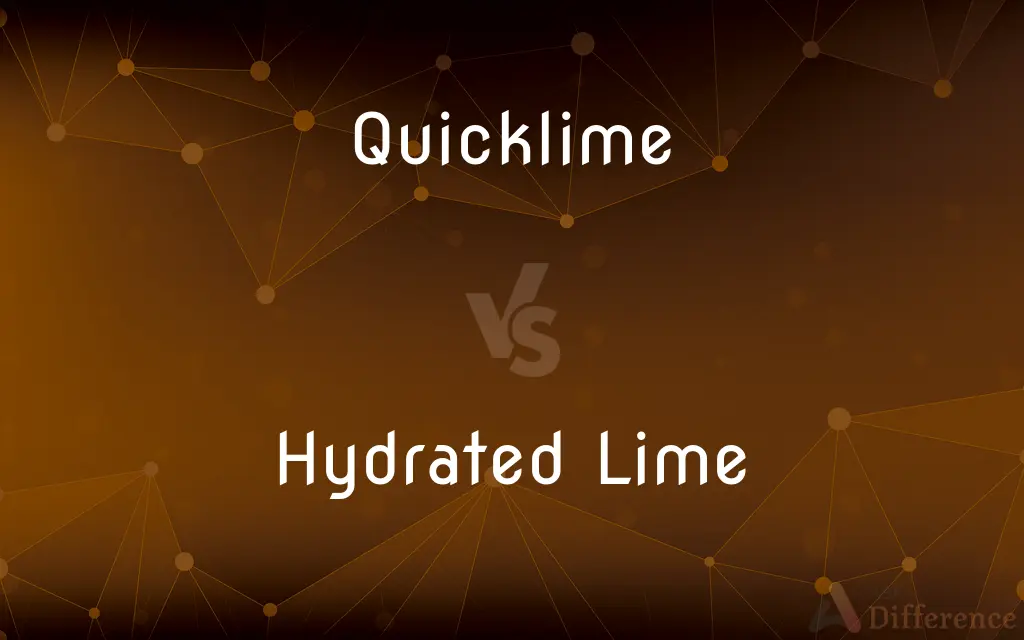Quicklime vs. Hydrated Lime — What's the Difference?
By Tayyaba Rehman & Fiza Rafique — Published on October 31, 2023
Quicklime is calcium oxide (CaO) produced by heating limestone, while hydrated lime is calcium hydroxide (Ca(OH)₂) made by adding water to quicklime.

Difference Between Quicklime and Hydrated Lime
Table of Contents
ADVERTISEMENT
Key Differences
Quicklime is a white, caustic, alkaline crystalline solid derived from heating limestone (calcium carbonate) to high temperatures. This heating process is called calcination. On the other hand, hydrated lime, also known as slaked lime, results from adding a controlled amount of water to quicklime, a process which hydrates the quicklime and changes its chemical structure.
In the realm of construction, quicklime is known for its property to release a large amount of heat when it reacts with water. This makes it useful in certain applications where heat generation can aid the process. Hydrated lime, on the other hand, is commonly used as a component in mortars and plasters due to its improved workability and reduced setting time.
The manufacturing process of these substances varies significantly. Quicklime is produced directly from the calcination of limestone, where it loses carbon dioxide and turns into a highly reactive material. Conversely, to produce hydrated lime, water is added to the quicklime in a controlled manner, leading to a less reactive compound.
In the industry, the use of quicklime and hydrated lime differs based on their properties. While quicklime can be used in steel manufacturing, water treatment, and flue gas treatment, hydrated lime finds its primary applications in waste treatment, water purification, and construction.
Both quicklime and hydrated lime have distinct safety considerations. Due to its highly exothermic reaction with water, quicklime can cause burns and requires careful handling. Meanwhile, hydrated lime is less caustic but can still cause irritation if it comes into contact with skin or eyes.
ADVERTISEMENT
Comparison Chart
Chemical Composition
Calcium oxide (CaO)
Calcium hydroxide (Ca(OH)₂)
Production
From heating limestone
By adding water to quicklime
Reactivity
Highly reactive with water
Less reactive
Uses
Steel manufacturing, flue gas treatment
Mortars, plasters, water purification
Safety Concerns
Can cause burns due to exothermic reactions
Can cause skin or eye irritation
Compare with Definitions
Quicklime
Used in various industries.
Steel mills incorporate Quicklime in their production process.
Hydrated Lime
Also known as slaked lime.
Hydrated Lime is used to improve the consistency of mortars.
Quicklime
A product of limestone calcination.
The kiln produces Quicklime through the calcination of limestone.
Hydrated Lime
Less reactive than quicklime.
Compared to Quicklime, Hydrated Lime is safer to handle.
Quicklime
White, caustic alkaline substance.
When handling Quicklime, protective equipment is essential due to its caustic nature.
Hydrated Lime
Used in construction and waste treatment.
Hydrated Lime helps in stabilizing roads by improving the soil's properties.
Quicklime
Calcium oxide derived from limestone.
Factories use Quicklime in various industrial processes.
Hydrated Lime
Calcium hydroxide produced from quicklime.
Hydrated Lime is essential in many water treatment processes.
Quicklime
Highly reactive with water.
Quicklime releases heat when it interacts with water.
Hydrated Lime
Result of controlled hydration of quicklime.
By adding water to Quicklime, factories produce Hydrated Lime.
Quicklime
See calcium oxide.
Quicklime
Calcium oxide, which is produced by heating (calcining) limestone and gives slaked lime on treatment with water.
Quicklime
(transitive) To treat with quicklime.
Quicklime
Calcium oxide; unslacked lime; - so called because when wet it develops great heat. See 4th Lime, 2.
Quicklime
A white crystalline oxide used in the production of calcium hydroxide
Common Curiosities
What's the chemical formula of Quicklime?
The chemical formula of Quicklime is CaO.
Can Quicklime be safely touched with bare hands?
No, Quicklime is caustic and can cause burns when it reacts with moisture.
What are the safety concerns associated with Hydrated Lime?
While less caustic than Quicklime, Hydrated Lime can cause skin or eye irritation.
How does the reactivity of Hydrated Lime compare to Quicklime?
Hydrated Lime is less reactive than Quicklime.
Which is more caustic, Quicklime or Hydrated Lime?
Quicklime is more caustic than Hydrated Lime.
Is there a significant price difference between Quicklime and Hydrated Lime?
Prices can vary based on region, quality, and demand, but generally, Quicklime is cheaper due to simpler production.
What is Quicklime commonly used for?
Quicklime is used in steel manufacturing, flue gas treatment, and some water treatment processes.
Why is Hydrated Lime added to mortars?
Hydrated Lime improves the workability and reduced setting time of mortars.
Can Hydrated Lime be used for soil stabilization?
Yes, Hydrated Lime is commonly used for soil stabilization in road construction.
How is Hydrated Lime produced?
Hydrated Lime is produced by adding a controlled amount of water to Quicklime.
How is Quicklime produced?
Quicklime is produced by heating limestone to high temperatures in a process called calcination.
Why is the controlled addition of water essential when producing Hydrated Lime?
A controlled addition ensures the desired chemical composition and minimizes safety risks.
Is the reaction between Quicklime and water endothermic or exothermic?
The reaction between Quicklime and water is exothermic.
Do both Quicklime and Hydrated Lime find applications in water treatment?
Yes, both are used in different water treatment processes based on their properties.
Are Quicklime and Hydrated Lime environmentally friendly?
Generally, both are considered environmentally benign, but their production can emit CO2, a greenhouse gas.
Share Your Discovery

Previous Comparison
Acetic Acid vs. Vinegar
Next Comparison
Karate vs. Martial ArtsAuthor Spotlight
Written by
Tayyaba RehmanTayyaba Rehman is a distinguished writer, currently serving as a primary contributor to askdifference.com. As a researcher in semantics and etymology, Tayyaba's passion for the complexity of languages and their distinctions has found a perfect home on the platform. Tayyaba delves into the intricacies of language, distinguishing between commonly confused words and phrases, thereby providing clarity for readers worldwide.
Co-written by
Fiza RafiqueFiza Rafique is a skilled content writer at AskDifference.com, where she meticulously refines and enhances written pieces. Drawing from her vast editorial expertise, Fiza ensures clarity, accuracy, and precision in every article. Passionate about language, she continually seeks to elevate the quality of content for readers worldwide.
















































